1感官系动词讲解与练习
- 格式:doc
- 大小:33.50 KB
- 文档页数:3
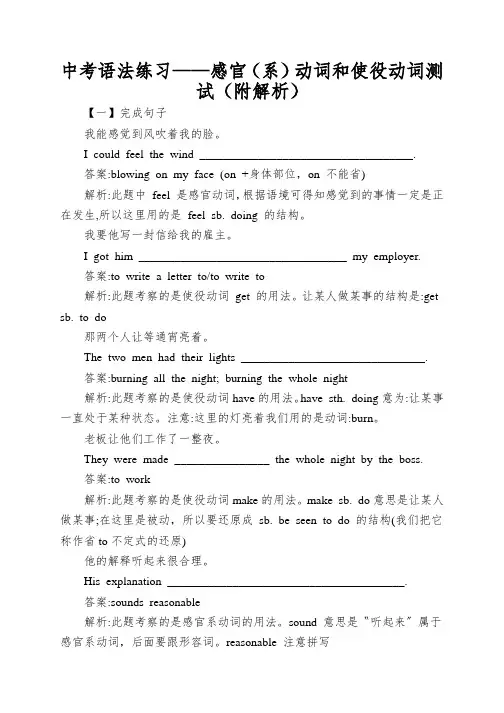
中考语法练习——感官(系)动词和使役动词测试(附解析)【一】完成句子我能感觉到风吹着我的脸。
I could feel the wind ____________________________________.答案:blowing on my face (on +身体部位,on 不能省)解析:此题中feel 是感官动词,根据语境可得知感觉到的事情一定是正在发生,所以这里用的是feel sb. doing 的结构。
我要他写一封信给我的雇主。
I got him ___________________________________ my employer.答案:to write a letter to/to write to 解析:此题考察的是使役动词get 的用法。
让某人做某事的结构是:get sb. to do 那两个人让等通宵亮着。
The two men had their lights _______________________________.答案:burning all the night; burning the whole night解析:此题考察的是使役动词have的用法。
have sth. doing意为:让某事一直处于某种状态。
注意:这里的灯亮着我们用的是动词:burn。
老板让他们工作了一整夜。
They were made ________________ the whole night by the boss.答案:to work解析:此题考察的是使役动词make的用法。
make sb. do意思是让某人做某事;在这里是被动,所以要还原成sb. be seen to do 的结构(我们把它称作省to不定式的还原)他的解释听起来很合理。
His explanation ________________________________________.答案:sounds reasonable解析:此题考察的是感官系动词的用法。
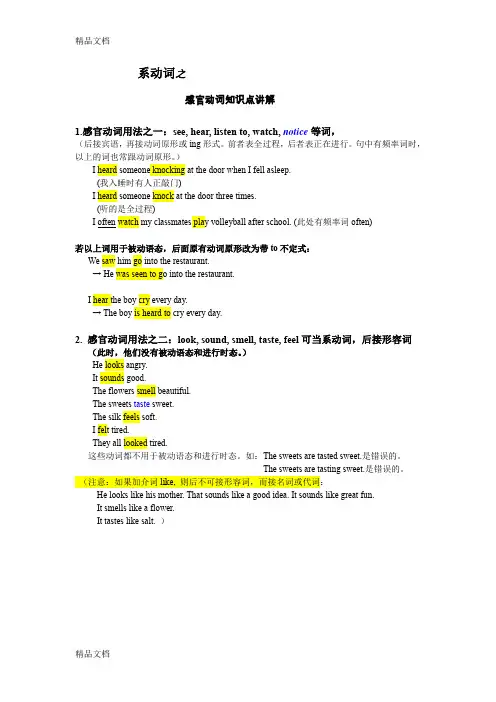
系动词之感官动词知识点讲解1.感官动词用法之一:see, hear, listen to, watch, notice等词,(后接宾语,再接动词原形或ing形式。
前者表全过程,后者表正在进行。
句中有频率词时,以上的词也常跟动词原形。
)I heard someone knocking at the door when I fell asleep.(我入睡时有人正敲门)I heard someone knock at the door three times.(听的是全过程)I often watch my classmates play volleyball after school. (此处有频率词often)若以上词用于被动语态,后面原有动词原形改为带to不定式:We saw him go into the restaurant.→ He was seen to go into the restaurant.I hear the boy cry every day.→ The boy is heard to cry every day.2. 感官动词用法之二:look, sound, smell, taste, feel可当系动词,后接形容词(此时,他们没有被动语态和进行时态。
)He looks angry.It sounds good.The flowers smell beautiful.The sweets taste sweet.The silk feels soft.I felt tired.They all looked tired.这些动词都不用于被动语态和进行时态。
如:The sweets are tasted sweet.是错误的。
The sweets are tasting sweet.是错误的。
(注意:如果加介词like, 则后不可接形容词,而接名词或代词:He looks like his mother. That sounds like a good idea. It sounds like great fun.It smells like a flower.It tastes like salt. )系动词之感官动词与be动词练习I 用be、taste、seem、look、smell、feel、sound 的适当形式填空。
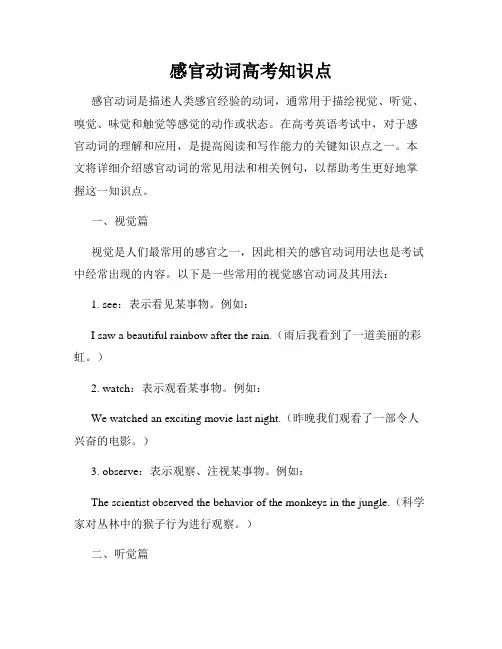
感官动词高考知识点感官动词是描述人类感官经验的动词,通常用于描绘视觉、听觉、嗅觉、味觉和触觉等感觉的动作或状态。
在高考英语考试中,对于感官动词的理解和应用,是提高阅读和写作能力的关键知识点之一。
本文将详细介绍感官动词的常见用法和相关例句,以帮助考生更好地掌握这一知识点。
一、视觉篇视觉是人们最常用的感官之一,因此相关的感官动词用法也是考试中经常出现的内容。
以下是一些常用的视觉感官动词及其用法:1. see:表示看见某事物。
例如:I saw a beautiful rainbow after the rain.(雨后我看到了一道美丽的彩虹。
)2. watch:表示观看某事物。
例如:We watched an exciting movie last night.(昨晚我们观看了一部令人兴奋的电影。
)3. observe:表示观察、注视某事物。
例如:The scientist observed the behavior of the monkeys in the jungle.(科学家对丛林中的猴子行为进行观察。
)二、听觉篇听觉是另一个重要的感官,同样也有一些常见的听觉感官动词需要掌握。
以下是一些常用的听觉感官动词及其用法:1. hear:表示听到某事物的声音。
例如:I heard a strange noise coming from the basement.(我听到地下室传来一阵奇怪的声音。
)2. listen:表示主动倾听某事物的声音。
例如:Please listen to me carefully when I explain the instructions.(当我解释说明书时,请仔细听我说。
)3. overhear:表示偶然听到某事物的声音。
例如:I accidentally overheard their conversation in the next room.(我无意中听到了隔壁房间的对话。
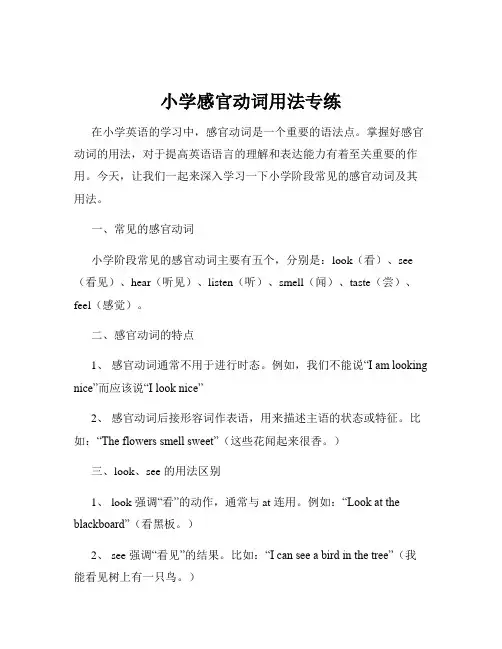
小学感官动词用法专练在小学英语的学习中,感官动词是一个重要的语法点。
掌握好感官动词的用法,对于提高英语语言的理解和表达能力有着至关重要的作用。
今天,让我们一起来深入学习一下小学阶段常见的感官动词及其用法。
一、常见的感官动词小学阶段常见的感官动词主要有五个,分别是:look(看)、see (看见)、hear(听见)、listen(听)、smell(闻)、taste(尝)、feel(感觉)。
二、感官动词的特点1、感官动词通常不用于进行时态。
例如,我们不能说“I am looking nice”而应该说“I look nice”2、感官动词后接形容词作表语,用来描述主语的状态或特征。
比如:“The flowers smell sweet”(这些花闻起来很香。
)三、look、see 的用法区别1、 look 强调“看”的动作,通常与 at 连用。
例如:“Look at the blackboard”(看黑板。
)2、 see 强调“看见”的结果。
比如:“I can see a bird in the tree”(我能看见树上有一只鸟。
)四、hear、listen 的用法区别1、 listen 强调“听”的动作,常与 to 连用。
例如:“Listen to me carefully”(认真听我说。
)2、 hear 强调“听见”的结果。
比如:“I can hear a dog barking”(我能听见一只狗在叫。
)五、smell、taste、feel 的用法1、 smell 表示“闻”,如:“The cake smells good”(蛋糕闻起来很好。
)2、 taste 表示“尝”,例如:“The soup tastes delicious”(这汤尝起来很美味。
)3、 feel 表示“感觉”,可以是身体上的感觉,也可以是心理上的感觉。
比如:“I feel happy today”(我今天感觉很开心。
)“The water feels cold”(这水感觉很冷。
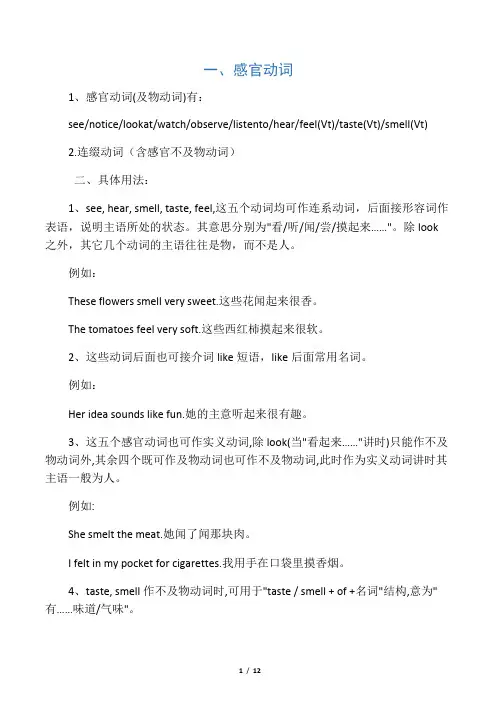
一、感官动词1、感官动词(及物动词)有:see/notice/lookat/watch/observe/listento/hear/feel(Vt)/taste(Vt)/smell(Vt)2.连缀动词(含感官不及物动词)二、具体用法:1、see, hear, smell, taste, feel,这五个动词均可作连系动词,后面接形容词作表语,说明主语所处的状态。
其意思分别为"看/听/闻/尝/摸起来……"。
除look 之外,其它几个动词的主语往往是物,而不是人。
例如:These flowers smell very sweet.这些花闻起来很香。
The tomatoes feel very soft.这些西红柿摸起来很软。
2、这些动词后面也可接介词like短语,like后面常用名词。
例如:Her idea sounds like fun.她的主意听起来很有趣。
3、这五个感官动词也可作实义动词,除look(当"看起来……"讲时)只能作不及物动词外,其余四个既可作及物动词也可作不及物动词,此时作为实义动词讲时其主语一般为人。
例如:She smelt the meat.她闻了闻那块肉。
I felt in my pocket for cigarettes.我用手在口袋里摸香烟。
4、taste, smell作不及物动词时,可用于"taste / smell + of +名词"结构,意为"有……味道/气味"。
例如:The air in the room smells of earth.房间里的空气有股泥土味。
5、它们(sound除外)可以直接作名词,与have或take构成短语。
例如:May I have a taste of the mooncakes?我可以尝一口这月饼吗?taste有品位、味道的意思。
例如:I don’t like the taste of the garlic.我不喜欢大蒜的味道。
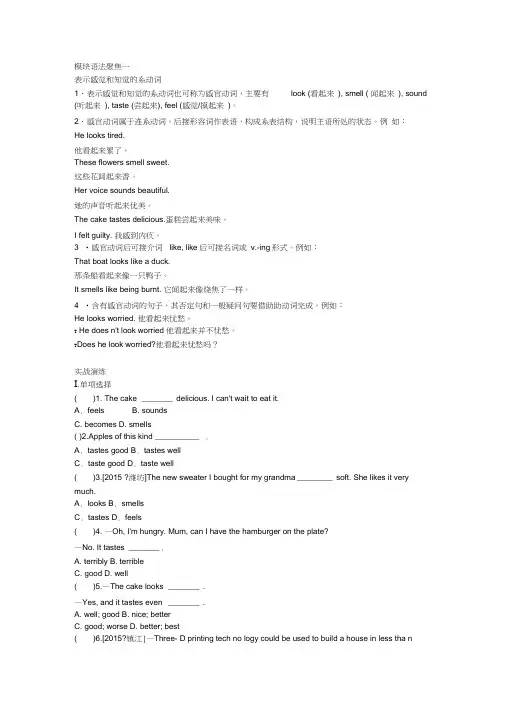
模块语法聚焦一表示感觉和知觉的系动词1.表示感觉和知觉的系动词也可称为感官动词,主要有look (看起来), smell ( 闻起来), sound (听起来), taste (尝起来), feel (感觉/摸起来)。
2.感官动词属于连系动词,后接形容词作表语,构成系表结构,说明主语所处的状态。
例如:He looks tired.他看起来累了。
These flowers smell sweet.这些花闻起来香。
Her voice sounds beautiful.她的声音听起来优美。
The cake tastes delicious.蛋糕尝起来美味。
I felt guilty. 我感到内疚。
3 •感官动词后可接介词like, like后可接名词或v.-ing形式。
例如:That boat looks like a duck.那条船看起来像一只鸭子。
It smells like being burnt. 它闻起来像烧焦了一样。
4 •含有感官动词的句子,其否定句和一般疑问句要借助助动词完成。
例如:He looks worried. 他看起来忧愁。
T He does n't look worried 他看起来并不忧愁。
T Does he look worried?他看起来忧愁吗?实战演练I.单项选择( )1. The cake _______ delicious. I can't wait to eat it.A. feelsB. soundsC. becomesD. smells( )2.Apples of this kind __________ .A. tastes goodB. tastes wellC. taste goodD. taste well( )3.[2015 ?潍坊]The new sweater I bought for my grandma ________ soft. She likes it very much.A. looksB. smellsC. tastesD. feels( )4. —Oh, I'm hungry. Mum, can I have the hamburger on the plate?—No. It tastes _______ .A. terriblyB. terribleC. goodD. well( )5.—The cake looks _______ .—Yes, and it tastes even _______ .A. well; goodB. nice; betterC. good; worseD. better; best( )6.[2015?镇江]—Three- D printing tech no logy could be used to build a house in less tha n24 hours.—It ______ amazing. It's my first time to get to know the news.A.looks B.smells C.sounds D.tastes( )7.Oh, it ___________so nice. What beautiful music it is!A.smells B.soundsC.tastes D.looks( )8.—Dinner is ready. Help yourself!—Wow! It ______ delicious. You are really good at cooking.A.looks B.soundsC.tastes D.feels( )9.—Let's go on a picnic this weekend, OK?—That sounds ______.A.great B.wellC.hardly D.terribly( )10.I like to read English in the garden because the flowers in it smell _______ .A.good B.wellC.bad D.badly( )11. —Do you like swimming in winter?—Of course. The water ______ a bit cold at first, but then I am warm and full of energy. A.tastes B.feels C.smells D.looks( )12.Mum is making dinner. It ___________ so nice!A.smells B.tastesC.feels D.sounds( )13.Good medicine for health __________ bitter to the mouth.A.feel B.tastes C.feels D.taste( )14.Some of my friends eat with their eyes. They prefer to order what _______ nice.A.feels B.smells C.looks D.tastes( )15. —Do you know the song Gangnam Style?—Of course. It ______ interesting.A.tastes B.smells C.sounds D.feelsn .根据汉语意思完成句子1.我的毛衣摸起来柔软。

中考语法练习——感官(系)动词和使役动词测试(附解析)【一】完成句子我能感觉到风吹着我的脸。
I could feel the wind ____________________________________.答案:blowing on my face (on +身体部位,on 不能省)解析:此题中feel 是感官动词,根据语境可得知感觉到的事情一定是正在发生,所以这里用的是feel sb. doing 的结构。
我要他写一封信给我的雇主。
I got him ___________________________________ my employer.答案:to write a letter to/to write to 解析:此题考察的是使役动词get 的用法。
让某人做某事的结构是:get sb. to do 那两个人让等通宵亮着。
The two men had their lights _______________________________.答案:burning all the night; burning the whole night解析:此题考察的是使役动词have的用法。
have sth. doing意为:让某事一直处于某种状态。
注意:这里的灯亮着我们用的是动词:burn。
老板让他们工作了一整夜。
They were made ________________ the whole night by the boss.答案:to work解析:此题考察的是使役动词make的用法。
make sb. do意思是让某人做某事;在这里是被动,所以要还原成sb. be seen to do 的结构(我们把它称作省to不定式的还原)他的解释听起来很合理。
His explanation ________________________________________.答案:sounds reasonable解析:此题考察的是感官系动词的用法。
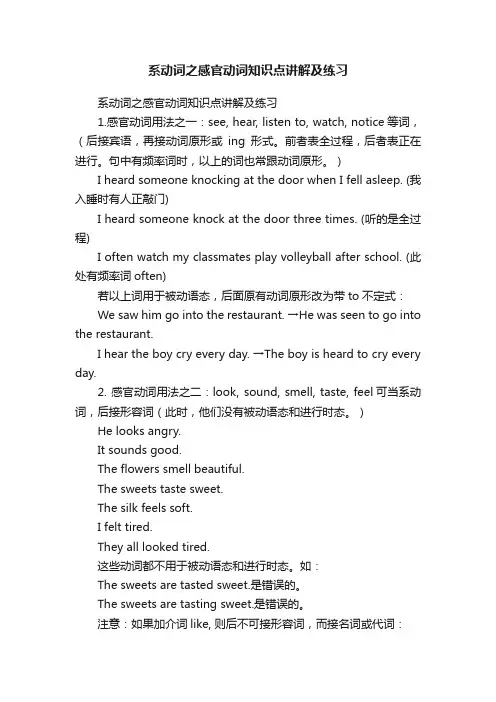
系动词之感官动词知识点讲解及练习系动词之感官动词知识点讲解及练习1.感官动词用法之一:see, hear, listen to, watch, notice等词,(后接宾语,再接动词原形或ing形式。
前者表全过程,后者表正在进行。
句中有频率词时,以上的词也常跟动词原形。
)I heard someone knocking at the door when I fell asleep. (我入睡时有人正敲门)I heard someone knock at the door three times. (听的是全过程)I often watch my classmates play volleyball after school. (此处有频率词often)若以上词用于被动语态,后面原有动词原形改为带to不定式:We saw him go into the restaurant. →He was seen to go into the restaurant.I hear the boy cry every day. →The boy is heard to cry every day.2. 感官动词用法之二:look, sound, smell, taste, feel可当系动词,后接形容词(此时,他们没有被动语态和进行时态。
)He looks angry.It sounds good.The flowers smell beautiful.The sweets taste sweet.The silk feels soft.I felt tired.They all looked tired.这些动词都不用于被动语态和进行时态。
如:The sweets are tasted sweet.是错误的。
The sweets are tasting sweet.是错误的。
注意:如果加介词like, 则后不可接形容词,而接名词或代词:He looks like his mother.That sounds like a good idea.It sounds like great fun.It smells like a flower.It tastes like salt.系动词之感官动词与be动词练习I 用be、taste、seem、look、smell、feel、sound 的适当形式填空。
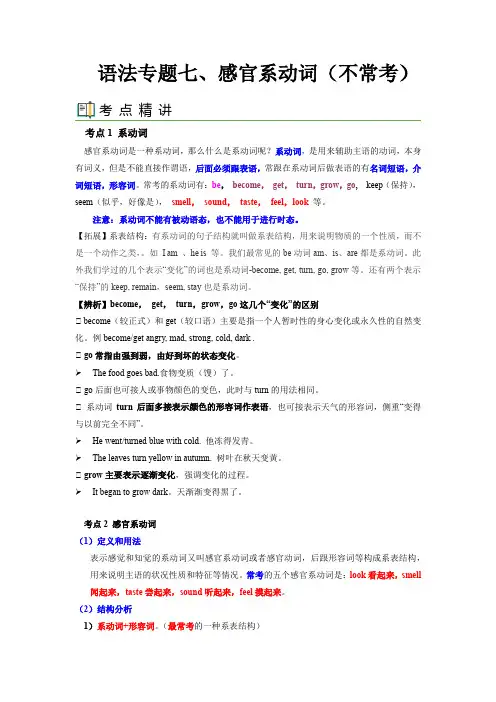
语法专题七、感官系动词(不常考)考点精讲考点1 系动词感官系动词是一种系动词,那么什么是系动词呢?系动词,是用来辅助主语的动词,本身有词义,但是不能直接作谓语,后面必须跟表语,常跟在系动词后做表语的有名词短语,介词短语,形容词。
常考的系动词有:be,become,get,turn,grow,go, keep(保持),seem(似乎,好像是),smell,sound,taste,feel,look等。
注意:系动词不能有被动语态,也不能用于进行时态。
【拓展】系表结构:有系动词的句子结构就叫做系表结构,用来说明物质的一个性质,而不是一个动作之类,。
如I am 、he is 等。
我们最常见的be动词am、is、are都是系动词。
此外我们学过的几个表示“变化”的词也是系动词-become, get, turn, go, grow等。
还有两个表示“保持”的keep, remain,seem, stay也是系动词。
【辨析】become,get,turn,grow,go这几个“变化”的区别① become(较正式)和get(较口语)主要是指一个人暂时性的身心变化或永久性的自然变化。
例become/get angry, mad, strong, cold, dark .② go常指由强到弱,由好到坏的状态变化。
➢The food goes bad.食物变质(馊)了。
① go后面也可接人或事物颜色的变色,此时与turn的用法相同。
① 系动词turn后面多接表示颜色的形容词作表语,也可接表示天气的形容词,侧重“变得与以前完全不同”。
➢He went/turned blue with cold. 他冻得发青。
➢The leaves turn yellow in autumn. 树叶在秋天变黄。
② grow主要表示逐渐变化,强调变化的过程。
➢It began to grow dark。
天渐渐变得黑了。
考点2 感官系动词(1)定义和用法表示感觉和知觉的系动词又叫感官系动词或者感官动词,后跟形容词等构成系表结构,用来说明主语的状况性质和特征等情况。

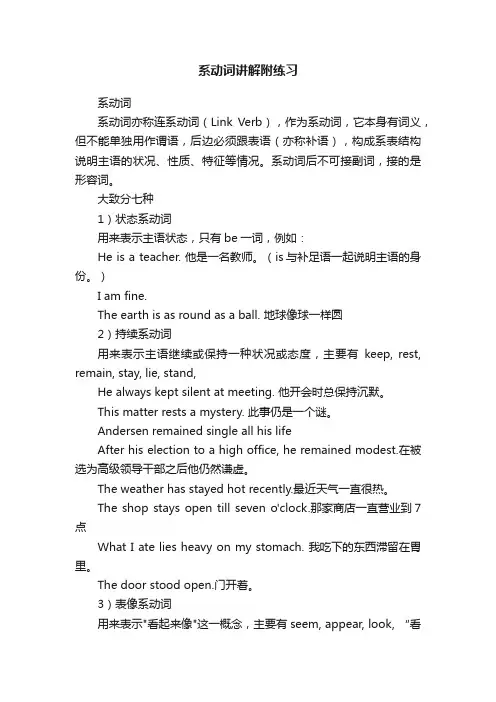
系动词讲解附练习系动词系动词亦称连系动词(Link Verb),作为系动词,它本身有词义,但不能单独用作谓语,后边必须跟表语(亦称补语),构成系表结构说明主语的状况、性质、特征等情况。
系动词后不可接副词,接的是形容词。
大致分七种1)状态系动词用来表示主语状态,只有be一词,例如:He is a teacher. 他是一名教师。
(is与补足语一起说明主语的身份。
)I am fine.The earth is as round as a ball. 地球像球一样圆2)持续系动词用来表示主语继续或保持一种状况或态度,主要有keep, rest, remain, stay, lie, stand,He always kept silent at meeting. 他开会时总保持沉默。
This matter rests a mystery. 此事仍是一个谜。
Andersen remained single all his lifeAfter his election to a high office, he remained modest.在被选为高级领导干部之后他仍然谦虚。
The weather has stayed hot recently.最近天气一直很热。
The shop stays open till seven o'clock.那家商店一直营业到7点What I ate lies heavy on my stomach. 我吃下的东西滞留在胃里。
The door stood open.门开着。
3)表像系动词用来表示"看起来像"这一概念,主要有seem, appear, look, “看起来、显得”seem/ appear+(to be )adj/ nHe seems (to be) very sad. 他看起来很伤心。
She seemed (to be )an honest woman.她看上去是个老实人。
牛津译林英语五年级下册拓展专题:感官系动词一、感官系动词定义:feel/look/sound/smell/taste作为连系动词时,其意思分别为"摸起来/看起来/听起来/闻起来/尝起来"后面接形容词作表语,说明主语所处的状态。
除look之外,其它几个动词的主语往往是物,而不是人。
例如:These flowers smell very sweet. 这些花闻起来很香。
二、感官系动词用法:1. 感官系动词后面也可接介词like构成短语,like后面常用名词或代词。
例如:Her idea sounds like fun. 她的主意听起来很有趣。
2. 这五个感官动词如果后面接名词作宾语,则这里的感官动词为实义动词,后面必须跟副词修饰动词。
以look一词为例:He looked at me happily. (实义动词,“看”,后有宾语me,用副词happily修饰。
)He looked happy. (系动词,“看起来……”,后接形容词作表语。
)系动词使用注意事项:◇ 系动词无被动语态和进行时Your hand feels cold.The dish tastes good.变疑问句和否定句句时要借助助动词Does he look happy?It doesn’t smell fresh.三、练一练a) 单项选择()1. Does your sister look _______?A. happyB. happilyC. beautifullyD. nicely ()2. - Have you ever heard the song Welcome to Beijing?- Yes, it _______ nice.A. hearsB. soundsC. looksD. listens()3. The girl's voice sounds_____. Maybe she can become a good singer when she grows up.A. sweetB. sweetlyC. beautifullyD.greatly()4. - What is Mum cooking in the kitchen?- Fish, I guess. How nice it _________!A. looksB. soundsC. tastesD. smells ()5.The table______ very smooth.A. looksB. turnsC. feelsD. smells ()6. - Do you like the shirt?- Yes, it ____very soft.A. feltB. is feelingC. is feltD. feels()7.You ____ very pale.A. are soundingB. are lookingC. lookD. are seeing ()8.These apples taste _____.A. to be goodB. to be wellC. wellD. good ()9. Jack always _______ unhappy before exams.A. tastesB. feelsC. smellsD. feeling()10. Grandma, you must feel ___ after cleaning the house. Let’s take a rest.A. tiredB. wellC. goodD. angryb) 用所给词的适当形式填空1. The baby panda looks very _______(love).2. Don’t eat the fish. It smells _______(badly).3. The background music sounds _______(noise).4. The flower looks very _______(beautifully).5. The sweater _______(feel) very soft.参考答案a) 选择:1.A2.B3.A4.D5.C6.D7.C8.D9.B10.Ab) 用所给单词的恰当形式填空:1.lovely2.bad3.noisy4.beautiful5.feels。
感官动词的用法总结感官动词的用法总结1、感官动词的定义感官动词是指表示人的五官所感受到的各种物质和精神客观世界信息的动词,包括:see、hear、smell、taste、feel五种动词。
2、感官动词的用法(1)一般现在时:主语 + 感官动词 + 宾语例句:I see a bird in the tree.(2)一般过去时:主语 + saw / heard / smelled / tasted / felt + 宾语例句:I heard a loud noise last night.(3)现在完成时:主语 + have / has + seen / heard / smelled / tasted / felt + 宾语例句:I have seen the movie before.(4)过去完成时:主语 + had + seen / heard / smelled / tasted / felt + 宾语例句:He had seen the painting before he went to the museum.(5)现在进行时:主语 + be + seeing / hearing / smelling / tasting / feeling+ 宾语例句:She is hearing the music in the next room.(6)过去进行时:主语 + was / were + seeing / hearing / smelling / tasting / feeling + 宾语例句:He was tasting the soup when I came in.3、感官动词的特殊用法(1)see, hear, smell, taste, feel后面可以接形容词。
例句:I can see the beautiful flowers.(2)see, hear, smell, taste, feel后面可以接不定式。
感官系动词知识点嘿,朋友们!咱今儿来聊聊感官系动词呀!这玩意儿可有意思啦。
你看哈,像“看起来”“听起来”“闻起来”“摸起来”“尝起来”这些,不就是我们日常生活中经常用到的嘛!就说“看起来”吧,这多形象啊。
比如说,你看到一朵花,哎呀,那花看起来真美呀!这一下就把花的样子给描述出来了。
这就好像你在跟别人分享你眼中看到的美好,是不是特别生动?再说说“听起来”。
听到一首好听的歌,你就会说,这首歌听起来太棒啦!这不就把你对这首歌的感受传递给别人了嘛。
这就像是给声音画了一幅画,让别人也能感受到那美妙的旋律。
“闻起来”也很妙呀!路过一家面包店,那香味飘过来,你肯定会说,哇,这面包闻起来好香啊!一下子就把那诱人的味道给说出来了。
这感觉就像是香味钻进了你的鼻子,然后又从你的嘴里跑出来告诉别人一样。
“摸起来”呢,就像你摸到一件柔软的毛衣,你会说,这毛衣摸起来好舒服呀!这就是在表达你对手感的感受呀,让别人也能想象到那柔软的感觉。
还有“尝起来”。
吃到一口美味的食物,你会情不自禁地说,哇,这东西尝起来太好吃啦!这就是在和别人分享你的味觉体验呀,让别人也能流口水呢!这些感官系动词就像是我们生活中的小精灵,它们让我们能更准确地表达自己的感受,让别人也能更好地理解我们。
它们让我们的语言变得丰富多彩,不再是干巴巴的。
你想想,如果没有这些感官系动词,我们该怎么表达我们看到的、听到的、闻到的、摸到的、尝到的呢?那得多费劲呀!所以说呀,这些小小的动词,作用可大着呢!它们让我们的交流变得更有趣,更生动。
咱平时说话的时候,多用用这些感官系动词,那说出来的话得多有意思呀!比如说,“这道菜看起来就很好吃,闻起来更香,尝起来,哎呀,那简直绝了!”你说这样的描述是不是特别吸引人?总之,感官系动词就是我们语言中的宝贝呀,可别小瞧了它们!让我们好好利用它们,让我们的生活变得更加多姿多彩吧!。
牛津译林英语五年级下册拓展专题:感官系动词一、感官系动词定义:feel/look/sound/smell/taste作为连系动词时,其意思分别为"摸起来/看起来/听起来/闻起来/尝起来"后面接形容词作表语,说明主语所处的状态。
除look之外,其它几个动词的主语往往是物,而不是人。
例如:These flowers smell very sweet. 这些花闻起来很香。
二、感官系动词用法:1. 感官系动词后面也可接介词like构成短语,like后面常用名词或代词。
例如:Her idea sounds like fun. 她的主意听起来很有趣。
2. 这五个感官动词如果后面接名词作宾语,则这里的感官动词为实义动词,后面必须跟副词修饰动词。
以look一词为例:He looked at me happily. (实义动词,“看”,后有宾语me,用副词happily修饰。
)He looked happy. (系动词,“看起来……”,后接形容词作表语。
)系动词使用注意事项:◇ 系动词无被动语态和进行时Your hand feels cold.The dish tastes good.变疑问句和否定句句时要借助助动词Does he look happy?It doesn’t smell fresh.三、练一练a) 单项选择()1. Does your sister look _______?A. happyB. happilyC. beautifullyD. nicely ()2. - Have you ever heard the song Welcome to Beijing?- Yes, it _______ nice.A. hearsB. soundsC. looksD. listens()3. The girl's voice sounds_____. Maybe she can become a good singer when she grows up.A. sweetB. sweetlyC. beautifullyD.greatly()4. - What is Mum cooking in the kitchen?- Fish, I guess. How nice it _________!A. looksB. soundsC. tastesD. smells ()5.The table______ very smooth.A. looksB. turnsC. feelsD. smells ()6. - Do you like the shirt?- Yes, it ____very soft.A. feltB. is feelingC. is feltD. feels()7.You ____ very pale.A. are soundingB. are lookingC. lookD. are seeing ()8.These apples taste _____.A. to be goodB. to be wellC. wellD. good ()9. Jack always _______ unhappy before exams.A. tastesB. feelsC. smellsD. feeling()10. Grandma, you must feel ___ after cleaning the house. Let’s take a rest.A. tiredB. wellC. goodD. angryb) 用所给词的适当形式填空1. The baby panda looks very _______(love).2. Don’t eat the fish. It smells _______(badly).3. The background music sounds _______(noise).4. The flower looks very _______(beautifully).5. The sweater _______(feel) very soft.参考答案a) 选择:1.A2.B3.A4.D5.C6.D7.C8.D9.B10.Ab) 用所给单词的恰当形式填空:1.lovely2.bad3.noisy4.beautiful5.feels。
模块语法聚焦一
表示感觉和知觉的系动词
1.表示感觉和知觉的系动词也可称为感官动词,主要有look (看起来), smell (闻起来), sound (听起来), taste (尝起来), feel (感觉/摸起来)。
2.感官动词属于连系动词,后接形容词作表语,构成系表结构,说明主语所处的状态。
例如:
He looks tired.
他看起来累了。
These flowers smell sweet.
这些花闻起来香。
Her voice sounds beautiful.
她的声音听起来优美。
The cake tastes delicious.蛋糕尝起来美味。
I felt guilty.我感到内疚。
3.感官动词后可接介词like, like后可接名词或v.ing形式。
例如:
That boat looks like a duck.
那条船看起来像一只鸭子。
It smells like being burnt.它闻起来像烧焦了一样。
4.含有感官动词的句子,其否定句和一般疑问句要借助助动词完成。
例如:
He looks worried. 他看起来忧愁。
→He doesn't look worried他看起来并不忧愁。
→Does he look worried?他看起来忧愁吗?
实战演练
Ⅰ. 单项选择
()1. The cake ________ delicious. I can't wait to eat it.
A.feels B.sounds
C.becomes D.smells
()2.Apples of this kind ________.
A.tastes good B.tastes well
C.taste good D.taste well
()3.[2015•潍坊]The new sweater I bought for my grandma ________ soft. She likes it very much.
A.looks B.smells
C.tastes D.feels
()4. —Oh, I'm hungry. Mum, can I have the hamburger on the plate?
—No. It tastes________.
A. terribly
B. terrible
C. good
D. well
()5.—The cake looks ________.
—Yes, and it tastes even ________.
A. well; good
B. nice; better
C. good; worse
D. better; best
()6.[2015•镇江]—ThreeD printing technology could be used to build a house in less than
24 hours.
—It ________ amazing. It's my first time to get to know the news.
A.looks B.smells C.sounds D.tastes
()7.Oh, it________so nice. What beautiful music it is!
A.smells B.sounds
C.tastes D.looks
()8.—Dinner is ready. Help yourself!
—Wow! It ________ delicious. You are really good at cooking.
A.looks B.sounds
C.tastes D.feels
()9.—Let's go on a picnic this weekend, OK?
—That sounds________.
A.great B.well
C.hardly D.terribly
()10.I like to read English in the garden because the flowers in it smell ________. A.good B.well
C.bad D.badly
()11.—Do you like swimming in winter?
—Of course. The water ________ a bit cold at first, but then I am warm and full of energy. A.tastes B.feels
C.smells D.looks
()12.Mum is making dinner. It ________ so nice!
A.smells B.tastes
C.feels D.sounds
()13.Good medicine for health ________ bitter to the mouth.
A.feel B.tastes C.feels D.taste
()14.Some of my friends eat with their eyes. They prefer to order what ________ nice. A.feels B.smells C.looks D.tastes
()15.—Do you know the song Gangnam Style?
—Of course. It ________ interesting.
A.tastes B.smells C.sounds D.feels
Ⅱ.根据汉语意思完成句子
1.我的毛衣摸起来柔软。
My sweater ____________.
2.聚会听起来太吵了。
The party ____________________.
3.你妈妈看上去很年轻。
Your mother ______________________.
4.汤尝起来咸了。
The soup ___________________.
5.它闻起来新鲜吗?
_______ it _______________?
6.他看上去像一位专家。
He ___________ an expert.
7.这食物尝起来怎样?
________ ________ the food ________?
8.这个主意听起来有趣吗?
________ the idea ________ interesting?
9.你叔叔长什么样?
________ ________ your uncle ________ ________?
10.他当众讲话对并不紧张。
He ________ ________ ________.when he speaks in public.
Ⅲ.用所给词的适当形式填空
1.The cloud ________ (look) like a horse.
2.The coat _______ (feel) very soft. So she bought it at once. 3.The weather ______________ (get) warmer and warmer these days. 4.The man ______ (seem) to be very angry.
5.That idea ________ (sound) very great.
6.The baby panda looks very ________(love).
7.Don't eat the fish. It smells ________(badly).
8.The background music sounds ________(noise). Please turn it down. 9.—What do you think of the milk?
—Oh, it ________( taste ) good.
10.I felt ________(relax) lying in the sun. What a good time!。